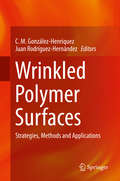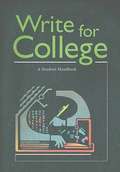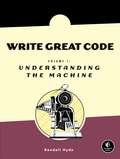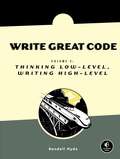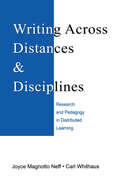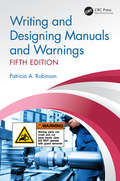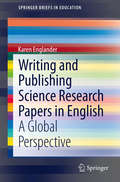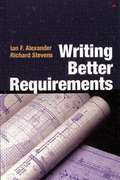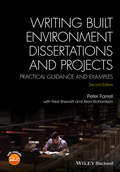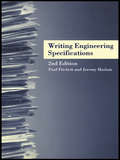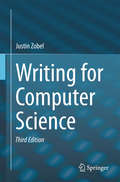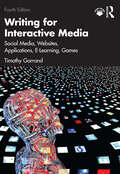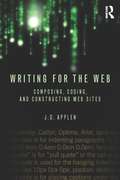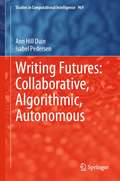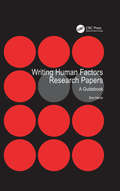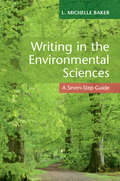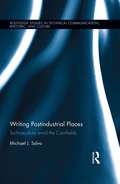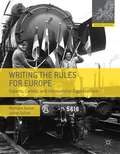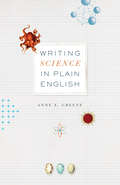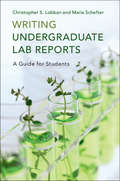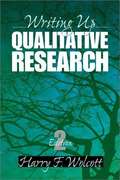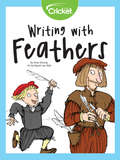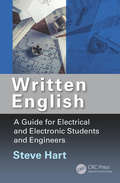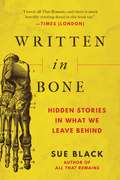- Table View
- List View
Wrinkled Polymer Surfaces: Strategies, Methods and Applications
by C. M. González-Henríquez Juan Rodríguez-HernándezThis book presents the state of the art in surface wrinkling, including current and future potential applications in biomedicine, tissue engineering, drug delivery, microfluidic devices, and other promising areas. Their use as templates, flexible electronics, and supports with controlled wettability and/or adhesion for biorelated applications demonstrate how the unique characteristics of wrinkled interfaces play a distinguishing and remarkable role. The fabrication approaches employed to induce wrinkle formation and the potential to fine-tune the amplitude and period of the wrinkles, their functionality, and their final morphology are thoroughly described. An overview of the main applications in which these buckled interfaces have already been employed or may have an impact in the near future is included. Presents a detailed description of the physical phenomena and strategies occurring at polymer surfaces to produce wrinkled surface patterns;Examines the different methodologies to produce morphology-controlled wrinkled surface patterns by means of physical and chemical treatment methods;Provides clear information on current and potential applications in flexible electronics and biomaterials, which are leading the use of these materials.
Write For College: A Student Handbook
by Patrick Sebranek Verne Meyer Dave KemperWrite for College emphasizes the kinds of writing that will prepare you for college course work. However, the handbook covers much more than writing. It also provides information and guidelines for speaking, thinking, critical reading, note taking, test taking, researching, and nearly every other topic essential to success.
Write Great Code, Volume 1: Understanding the Machine
by Randall HydeToday's programmers are often narrowly trained because the industry moves too fast. That's where Write Great Code, Volume 1: Understanding the Machine comes in. This, the first of four volumes by author Randall Hyde, teaches important concepts of machine organization in a language-independent fashion, giving programmers what they need to know to write great code in any language, without the usual overhead of learning assembly language to master this topic. A solid foundation in software engineering, The Write Great Code series will help programmers make wiser choices with respect to programming statements and data types when writing software.
Write Great Code, Volume 2: Thinking Low-Level, Writing High-Level
by Randall HydeIt's a critical lesson that today's computer science students aren't always being taught: How to carefully choose their high-level language statements to produce efficient code. Write Great Code, Volume 2: Thinking Low-Level, Writing High-Level shows software engineers what too many college and university courses don't - how compilers translate high-level language statements and data structures into machine code. Armed with this knowledge, they will make informed choices concerning the use of those high-level structures and help the compiler produce far better machine code - all without having to give up the productivity and portability benefits of using a high-level language.
Writing Across Distances and Disciplines: Research and Pedagogy in Distributed Learning
by Joyce Magnotto Neff Carl WhithausWriting Across Distances and Disciplines addresses questions that cross borders between onsite, hybrid, and distributed learning environments, between higher education and the workplace, and between distance education and composition pedagogy. This groundbreaking volume raises critical issues, clarifies key terms, reviews history and theory, analyzes current research, reconsiders pedagogy, explores specific applications of WAC and WID in distributed environments, and considers what business and education might teach one another about writing and learning. Exploring the intersection of writing across the curriculum, composition studies, and distance learning , it provides an in-depth look at issues of importance to students, faculty, and administrators regarding the technological future of writing and learning in higher education.
Writing and Designing Manuals and Warnings, Fifth Edition
by Patricia A. RobinsonTechnology is changing the way we do business, the way we communicate with each other, and the way we learn. This new edition is intended to help technical writers, graphic artists, engineers, and others who are charged with producing product documentation in the rapidly changing technological world. While preserving the basic guidelines for developing manuals and warnings presented in the previous edition, this new edition offers new material as well, including a much-expanded section on hazard analysis. Features Provides more explicit guidance on conducting a hazard analysis, including methods and documentation Offers in-depth discussion of digital platforms, including video, animations, and even virtual reality, to provide users with operating instructions and safety information Incorporates current research into effective cross-cultural communication—essential in today’s global economy Explains new US and international standards for warning labels and product instructions Presents expanded material on user analysis, including addressing generational differences in experience and preferred learning styles Writing and Designing Manuals and Warnings, Fifth Edition explores how emerging technologies are changing the world of product documentation from videos to virtual reality and all points in between.
Writing and Publishing Science Research Papers in English
by Karen EnglanderThis book provides a comprehensive review of the current knowledge on writing and publishing scientific research papers and the social contexts. It deals with both English and non-Anglophone science writers, and presents a global perspective and an international focus. The book collects and synthesizes research from a range of disciplines, including applied linguistics, the sociology of science, sociolinguistics, bibliometrics, composition studies, and science education. This multidisciplinary approach helps the reader gain a solid understanding of the subject. Divided into three parts, the book considers the context of scientific papers, the text itself, and the people involved. It explains how the typical sections of scientific papers are structured. Standard English scientific writing style is also compared with science papers written in other languages. The book discusses the strengths and challenges faced by people with different degrees of science writing expertise and the role of journal editors and reviewers.
Writing Better Requirements
by Richard Stevenson Ian F. AlexanderIf you are involved in the systems engineering process in any company, you will learn how to write requirements to get the system you want.
Writing Built Environment Dissertations and Projects: Practical Guidance and Examples
by Fred Sherratt Alan Richardson Peter FarrellWriting Built Environment Dissertations and Projects will help you to write a good dissertation or project by giving you a good understanding of what should be included, and showing you how to use data collection and analysis tools in the course of your research. Addresses prominent weaknesses in under-graduate dissertations including weak data collection; superficial analysis and poor reliability and validity Includes many more in-depth examples making it easy to understand and assimilate the concepts presented Issues around study skills and ethics are embedded throughout the book and the many examples encourage you to consider the concepts of reliability and validity Second edition includes a new chapter on laboratory based research projects Supporting website with sample statistical calculations and additional examples from a wider range of built environment subjects
Writing Engineering Specifications
by Paul Fitchett Jeremy HaslamEngineers need to understand the legal and commercial context in which they draw up technical specifications. This thoroughly up-dated edition of Haslam's successful Writing Engineering Specifications provides a concise guide to technical specifications and leads the reader through the process of writing these instructions, with clear advice to help the student and professional avoid legal disputes or the confusion and time wasting caused by poor drafting. Designers and project managers should find this invaluable, and it should be helpful to insurers, lawyers, estimators and the like.
Writing for Computer Science
by Justin ZobelAll researchers need to write or speak about their work, and to have research that is worth presenting. Based on the author's decades of experience as a researcher and advisor, this third edition provides detailed guidance on writing and presentations and a comprehensive introduction to research methods, the how-to of being a successful scientist. Topics include: · Development of ideas into research questions; · How to find, read, evaluate and referee other research; · Design and evaluation of experiments and appropriate use of statistics; · Ethics, the principles of science and examples of science gone wrong. Much of the book is a step-by-step guide to effective communication, with advice on: · Writing style and editing; · Figures, graphs and tables; · Mathematics and algorithms; · Literature reviews and referees' reports; · Structuring of arguments and results into papers and theses; · Writing of other professional documents; · Presentation of talks and posters. Written in an accessible style and including handy checklists and exercises, Writing for Computer Science is not only an introduction to the doing and describing of research, but is a valuable reference for working scientists in the computing and mathematical sciences.
Writing for Interactive Media: Social Media, Websites, Applications, e-Learning, Games
by Timothy GarrandThis thoroughly revised fourth edition teaches students and professionals how to create interactive content for all types of new media and become successful writers or designers in a variety of fields. This comprehensive guide is grounded in the core principles and skills of interactive media writing, in which writers create text and structure content to guide users through interactive products such as websites or software. The book examines case studies on interactive formats including complex informational websites, computer games, e-learning courses, training programs, and immersive exhibits. These case studies assess real-world products and documentation used by professional writers such as scripts, outlines, screenshots, and flowcharts. The book also provides practical advice on how to use interactive media writing skills to advance careers in the social media, technical, instructional communication, and creative media fields. This edition includes new chapters on UX Writing and Content Design, Social Media Writing, and Writing for Mobile. Writing for Interactive Media prepares students for the writing challenges of today’s technology and media. It can be used as a core textbook for courses in UX Writing, Writing for Digital Media, and Technical and Professional Communication and is a valuable resource for writing professionals at all levels. Supplemental resources include a sample syllabus, class assignments, student exercises, scripts, outlines, flowcharts, and other interactive writing samples. They are available online at www.routledge.com/9781032554242
Writing for the Web: Composing, Coding, and Constructing Web Sites
by J. D. ApplenWriting for the Web unites theory, technology, and practice to explore writing and hypertext for website creation. It integrates such key topics as XHTML/CSS coding, writing (prose) for the Web, the rhetorical needs of the audience, theories of hypertext, usability and architecture, and the basics of web site design and technology. Presenting information in digestible parts, this text enables students to write and construct realistic and manageable Web sites with a strong theoretical understanding of how online texts communicate to audiences. Key features of the book include: Screenshots of contemporary Web sites that will allow students to understand how writing for and linking to other layers of a Web site should work. Flow charts that describe how Web site architecture and navigation works. Parsing exercises in which students break down information into subsets to demonstrate how Web site architecture can be usable and scalable. Detailed step-by-step descriptions of how to use basic technologies such as file transfer protocols (FTP). Hands-on projects for students to engage in that allow them to connect the various components in the text. A companion website with downloadable code and additional pedagogical features: www.routledge.com/cw/applen ? Writing for the Web prepares students to work in professional roles, as it facilitates understanding of architecture and arrangement of written content of an organization’s texts.
Writing Futures: Collaborative, Algorithmic, Autonomous (Studies in Computational Intelligence #969)
by Ann Hill Duin Isabel PedersenThis book is useful to understand and write alongside non-human agents, examine the impact of algorithms and AI on writing, and accommodate relationships with autonomous agents. This ground-breaking future-driven framework prepares scholars and practitioners to investigate and plan for the social, digital literacy, and civic implications arising from emerging technologies. This book prepares researchers, students, practitioners, and citizens to work with AI writers, virtual humans, and social robots. This book explores prompts to envision how fields and professions will change. The book’s unique integration with Fabric of Digital Life, a database and structured content repository for conducting social and cultural analysis of emerging technologies, provides concrete examples throughout. Readers gain imperative direction for collaborative, algorithmic, and autonomous writing futures.
Writing Human Factors Research Papers: A Guidebook
by Don HarrisWriting high-quality papers suitable for publication within international scientific journals is now an essential skill for all early-career researchers; their career progression and the reputation of the department in which they work depends upon it. However, many manuscripts are rejected or sent back for major re-working not because the science they contain is in any way 'bad', but because the same problems keep occurring in the way that the material is presented. It is one thing to write a good scientific paper, however it is quite another thing to get it published. This requires some additional nous. In writing this book Don Harris draws upon nearly a quarter of a century of experience as an author and reviewer of research papers, and ultimately as a journal editor. By his own admission, it contains all the things he wished that his mentors had told him 25 years ago, but didn't. The material in the book is drawn from many years of finding all these things out for himself, usually by trial and error (but mostly error!). The text adopts a much lighter touch than is normally found in books of this type - after all, who really wants to read a book about writing research papers? The author describes his own unique approach to writing journal papers (which, in his own words, has proved to be extremely successful). All major points are illustrated with examples from his own, published works. The book is written in the form of a manual for constructing a journal manuscript: read a chapter, write a section. However, the material it contains goes beyond just this and also describes how to select a target journal, the manuscript submission process, what referees are looking for in a good journal paper, and how to deal with the referees' comments. Each chapter concludes with a checklist to ensure all the key elements have been addressed.
Writing in the Environmental Sciences: A Seven-Step Guide
by Baker L. MichelleAs an environmental scientist, you are used to writing scientific articles, but how confident do you feel writing policy or regulatory documents? Do you feel you have the necessary writing skills to influence policy and inform the public? This refreshingly clear guide provides environmental scientists and conservation professionals with an effective writing process that can be applied in a range of financial, political, or organizational contexts. Baker outlines a replicable seven-step writing formula based on practical experience that acknowledges the complexities inherent in the worlds of endangered species, habitat conservation, and recovery planning. Using the formula, scientists will be able to communicate confidently and successfully with a multitude of audiences. Baker's guide is written for scientists, not professional writers. In it, best practices abound. Practical examples, strategies, and diagrams guide the reader at every step, and selected resources are provided for further reference.
Writing Postindustrial Places: Technoculture amid the Cornfields (Routledge Studies in Technical Communication, Rhetoric, and Culture)
by Michael J. SalvoExploring the relationship between postindustrial writing and developments in energy production, manufacturing, and agriculture, Michael J. Salvo shows how technological and industrial innovation relies on communicative and organizational suppleness. Through representative case studies, Salvo demonstrates the ways in which technical communicators formulate opportunities that link resources with need. His book is a supple articulation of the opportunities and pitfalls that come with great change.
Writing The Rules For Europe: A Practical Guide To The Future
by Johan Schot Wolfram KaiserTechnologies have created crucial connections across borders requiring new forms of regulation. This book analyzes how experts, cartels and international organizations have written the rules for Europe since around 1850. Based on fresh research in the archives of multiple international organizations and European countries it explores the "hidden integration" of Europe forms of integration that were not always visible, but affected the citizens of Europe in their everyday lives. Richly illustrated and engagingly written, the book de-centers the present-day European Union in a new long-term understanding of European integration. "
Writing Science: How To Write Papers That Get Cited And Proposals That Get Funded
by Joshua SchimelAs a scientist, you are a professional writer: your career is built on successful proposals and papers. Success isn't defined by getting papers into print, but by getting them into the reader's consciousness. Writing Science is built upon the idea that successful science writing tells a story. It uses that insight to discuss how to write more effectively. Integrating lessons from other genres of writing with those from the author's years of experience as author, reviewer, and editor, the book shows scientists and students how to present their research in a way that is clear and that will maximize reader comprehension. The book takes an integrated approach, using the principles of story structure to discuss every aspect of successful science writing, from the overall structure of a paper or proposal to individual sections, paragraphs, sentences, and words. It begins by building core arguments, analyzing why some stories are engaging and memorable while others are quickly forgotten, and proceeds to the elements of story structure, showing how the structures scientists and researchers use in papers and proposals fit into classical models. The book targets the internal structure of a paper, explaining how to write clear and professional sections, paragraphs, and sentences in a way that is clear and compelling. The ideas within a paper should flow seamlessly, drawing readers along. The final section of the book deals with special challenges, such as how to discuss research limitations and how to write for the public.
Writing Science in Plain English
by Anne E. GreeneScientific writing is often dry, wordy, and difficult to understand. But, as Anne E. Greene shows in Writing Science in Plain English,writers from all scientific disciplines can learn to produce clear, concise prose by mastering just a few simple principles. This short, focused guide presents a dozen such principles based on what readers need in order to understand complex information, including concrete subjects, strong verbs, consistent terms, and organized paragraphs. The author, a biologist and an experienced teacher of scientific writing, illustrates each principle with real-life examples of both good and bad writing and shows how to revise bad writing to make it clearer and more concise. She ends each chapter with practice exercises so that readers can come away with new writing skills after just one sitting. Writing Science in Plain English can help writers at all levels of their academic and professional careers--undergraduate students working on research reports, established scientists writing articles and grant proposals, or agency employees working to follow the Plain Writing Act. This essential resource is the perfect companion for all who seek to write science effectively.
Writing Undergraduate Lab Reports: A Guide for Students
by Lobban Christopher S. María SchefterWriting clear, impactful reports is a crucial skill for science students, but few books focus on this area for the undergraduate. Particularly useful for biology students, this text adopts a hands-on approach, using example reports and published papers as models to put guidance into practice. An introductory chapter familiarizes undergraduates with the principles of writing science. Two model reports are then developed, walking students through experimental and observational teaching-lab reports. The structure and content of the Introduction, Methods and Materials, Results, and Discussion are explained, together with tips for the title, abstract, and references. Students are then guided on how to polish their first draft. The last section of the book analyzes two published papers, helping the reader transition to reporting original research. Clearly and concisely written, this text offers a much-needed lifeline for science students facing science report-writing for the first time, and for those looking to hone their writing skills.
Writing Up Qualitative Research
by Harry F. WolcottThis author provides practical advice on how to write up research results gleaned from qualitative studies.
Writing with Feathers
by Rupert Van Wyk Anne RooneyWriting is very important to all of us! But did you know that people in the past did not have the same kind of writing instrument that we use today? Instead of using plastic or metals to create pens, people in the past used feathers to create pens! This story gives a brief history of what people used to write with and how they eventually developed the feather pen! Not only will you have a history of writing, but you will also learn how to create your very own feather pen!
Written English: A Guide for Electrical and Electronic Students and Engineers
by Steve HartA research paper or graduate essay demonstrating weak English and poor formatting is likely to be rejected by an editor or marked down by an assessor; but why should these gaps in your English knowledge undermine your subject knowledge and skill as an engineer or student of the discipline? Written English: A Guide for Electrical and Electronic Students and Engineers is the first resource to work at the sentence level to resolve the English language problems facing international engineering students and scholars. Informed by hundreds of research papers and student essays, this valuable reference: Covers grammar essentials and key terms in the fields of electrical engineering, electronic engineering, and communication systems Uses real-world examples to reveal common mistakes and identify critical areas of focus Provides practical solutions to formatting, vocabulary, and stylistic issues Written English: A Guide for Electrical and Electronic Students and Engineers equips readers with the necessary knowledge to produce accurate and effective English when writing for engineering.
Written in Bone: Hidden Stories in What We Leave Behind
by Sue BlackFrom the author of All That Remains, a tour through the human skeleton and the secrets our bones reveal. Longlisted for the Crime Writers&’ Association ALCS Gold Dagger for Nonfiction. In her memoir All That Remains, internationally renowned forensic anthropologist and human anatomist Dame Sue Black recounted her life lived eye to eye with the Grim Reaper. During the course of it, she offered a primer on the basics of identifying human remains, plenty of insights into the fascinating processes of death, and a sober, compassionate understanding of its inescapable presence in our existence, all leavened with her wicked sense of humor. In her new book, Sue Black builds on the first, taking us on a guided tour of the human skeleton and explaining how each person's life history is revealed in their bones, which she calls "the last sentinels of our mortal life to bear witness to the way we lived it." Her narrative follows the skeleton from the top of the skull to the small bones in the foot. Each step of the journey includes an explanation of the biology—how the bone is formed in a person's development, how it changes as we age, the secrets it may hold—and is illustrated with anecdotes from the author's career helping solve crimes and identifying human remains, whether recent or historical. Written in Bone is full of entertaining stories that read like scenes from a true-life CSI drama, infused with humor and no-nonsense practicality about the realities of corpses and death.
